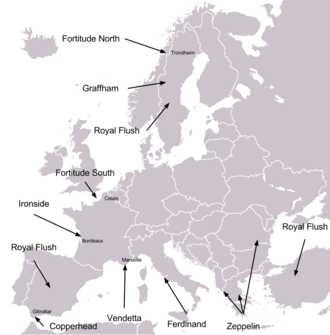Operation Quicksilver (deception plan)
| Quicksilver | |
|---|---|
| Part of Operation Bodyguard / Operation Fortitude | |
 The D-Day naval deceptions made up one part of Operation Bodyguard. | |
| Operational scope | Strategic Deception |
| Location | South East England |
| Planned | 1944 |
| Planned by | London Controlling Section, Ops (B), R Force |
| Target | Pas de Calais |
| Date | January - July 1944 |
| Outcome | Credited with contributing to the strategic success of D-Day landings, as part of the overall Bodyguard plan. |
Operation Quicksilver was a Second World War military deception. Undertaken by the Allies in 1944, the operation threatened an invasion of France in the Pas de Calais region through the simulation of a large Field Army in South East England. Quicksilver formed part of the Operation Fortitude deception, itself part of the strategic Operation Bodyguard plan. The key element of Quicksilver was the creation in German minds that "First United States Army Group" (FUSAG) commanded by General George Patton supposedly would land in the Pas-de-Calais for the major invasion of Europe, after the landings in Normandy had lured the German defenders to that front. (FUSAG was a genuine army group headquarters which later became Omar Bradley's 12th Army Group, but was given a fictitious role and many non-existent divisions for purposes of deception.)
Juan Pujol García, known by the British code name Garbo and the German code name Arabel, was a double agent loyal to the Allies who played a crucial role in the deception by supplying Germany with detailed information from a network of non-existent sub-agents supporting the idea that the main invasion was to be in the Pas-de-Calais.
Background
Quicksilver was a World War II deception operation conducted by the Allied Nations. It formed part of Operation Bodyguard, a broad strategic military deception intended to support the Allied invasion of German-occupied France in July 1944. Bodyguard was designed to confuse the Axis high command as to Allied intentions during the lead-up to the invasion. Operation Fortitude South was a sub-plan of Bodyguard which called for the fabrication of a non-existent field army in South East England, with the aim of threatening an invasion in the Pas de Calais region of France.[1]
The Allied story for FUSAG was that the army group, based in south-east England, would invade the Pas de Calais region several weeks after a smaller diversionary landing in Normandy. The order of battle for the army was intended to represent, to the German viewpoint, the bulk of Allied forces in England. Quicksilver was the code name for a number of physical deceptions to support the fabrication of FUSAG, including wireless deception, troop movements and bombing campaigns.[2]
Overview

Quicksilver was subdivided into six subplans numbered I through VI:
- Quicksilver I was the basic "story" for Fortitude: the First United States Army Group, based in the southeast of England, was to land in Pas-de-Calais after German reserves were committed to Normandy.[3]
- Quicksilver II was the radio deception plan of Quicksilver, involving the apparent movement of units from their true locations to southeastern England.[4]
- Quicksilver III was the display of dummy landing craft, including associated simulated wireless traffic and signing of roads and special areas.[5]
- Quicksilver IV was the air plan for Quicksilver, including bombing of the Pas-de-Calais beach area and tactical railway bombing immediately before D-Day.[6]
- Quicksilver V was increased activity around Dover (giving impression of extra tunneling, additional wireless stations), to suggest embarkation preparations.[7]
- Quicksilver VI was night lighting to simulate activity at night where dummy landing craft were situated.
Quicksilver, like the rest of Fortitude South, was devised by Colonel David Strangeways, Montgomery's deception officer, and carried out under his supervision. Strangeways was very adept at deceiving the Germans. His ideas throughout the war had the Germans duped many times.
The operation was carried out by means of false radio signals purporting to show units massing in southeastern England, together with false reports to German intelligence by double agents provided by the Double Cross System. Allowing one of the double agents to claim to have stolen documents describing the closely guarded invasion plans might have aroused suspicion. Instead, agents were allowed to report minutiae such as insignia on soldiers' uniforms and unit markings on vehicles. The observations in the south-central areas largely gave accurate information about the units located there: the actual invasion forces. Reports from southwest England indicated few troop sightings, when in reality many units were housed there. Reports from the southeast depicted the real and the notional Quicksilver forces. Any military planner would know that to mount a massive invasion of Europe from England, Allied units had to be staged around the country, with those that would land first nearest to the invasion point. German intelligence used the agent reports to construct an order of battle for the Allied forces that placed the center of gravity of the invasion force opposite Pas de Calais, the point on the French coast closest to England and therefore a likely invasion site. The deception was so effective that the Germans kept 15 reserve divisions near Calais even after the invasion had begun at Normandy, lest it prove to be a diversion from the "real" invasion at Calais.[8][9]
Contrary to a widespread misconception, the FUSAG deception was not primarily implemented with dummy tanks, airplanes, or other dummy equipment, since at that stage of the war the Germans were unable to fly reconnaissance planes over England and such effort would have been wasted. Dummy landing craft were stationed at ports in eastern and southeastern England where they might be observed by the Germans.[10][11] (The Allies did possess extensive dummy equipment, which was used in North Africa and later in continental Europe.)
References
- ↑ Latimer (2001), pp. 218–232
- ↑ Holt (2004), pp. 578–579
- ↑ Deuve, Jean. Histoire secrete des stratagemes de la Seconde Guerre mondiale. pp. 231–233. ISBN 978-83-7495-858-5.
- ↑ Deuve, Jean. Histoire secrete des stratagemes de la Seconde Guerre mondiale. 978-83-7495-858-5. pp. 234–238. ISBN 978-83-7495-858-5.
- ↑ Deuve, Jean. Histoire secrete des stratagemes de la Seconde Guerre mondiale. 978-83-7495-858-5. pp. 238–239. ISBN 978-83-7495-858-5.
- ↑ Deuve, Jean. Histoire secrete des stratagemes de la Seconde Guerre mondiale. 978-83-7495-858-5. pp. 239–242. ISBN 978-83-7495-858-5.
- ↑ Deuve, Jean. Histoire secrete des stratagemes de la Seconde Guerre mondiale. 978-83-7495-858-5. p. 242. ISBN 978-83-7495-858-5.
- ↑ Masterman, John C (1972) [1945], The Double-Cross System in the War of 1939 to 1945, Australian National University Press, p. 223ff, ISBN 978-0-7081-0459-0
- ↑ Moore, Alan T. (2009-12-01). "The Principles Of Military Deception And Operation Quicksilver". Retrieved 2013-04-16.
- ↑ Holt, Thaddeus (2004), The Deceivers: Allied Military Deception in the Second World War, New York: Scribner, p. 537, ISBN 0-7432-5042-7
- ↑ Howard, Michael (1990), British Intelligence in the Second World War, Vol. 5: Strategic Deception, New York: Cambridge U. Press, p. 120, ISBN 0-11-630954-7
Bibliography
- Holt, Thaddeus (2004). The Deceivers: Allied Military Deception in the Second World War. New York: Scribner. ISBN 0-7432-5042-7.
- Latimer, Jon (2001). Deception in War. New York: New York: Overlook Press. ISBN 978-1-58567-381-0.
- Levine, Joshua (2011). Operation Fortitude: The True Story of the Key Spy Operation of WWII That Saved D-Day. London: HarperCollins UK. ISBN 0-00-741324-6.